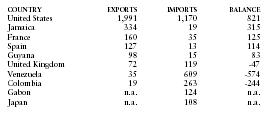Trinidad and Tobago - Foreign trade
The foreign trade of Trinidad and Tobago is very large for a country of its size, a fact attributable mainly to its petroleum processing industry, whereby crude oil is imported and then reexported as gasoline, kerosene, and other petroleum products. The economy's prosperity is thus tied closely to trade, which, in turn, is closely linked to the price and demand structure of the world petroleum market.
Up to 1992, the government prohibited the importation of some manufactured products without a license. The government replaced this list with supplemental tariffs, which coupled with the CARICOM Common External Tariff (CET), reached nearly 100%. These supplemental tariffs were reduced to CET levels by 1995, alleviating high prices on foreign goods. By 1996, quantitative restrictions were eliminated, as were surcharges and stamp duties on nonagricultural goods.
Trinidad and Tobago's main sources of commodity export income are refined petroleum products (39%), crude petroleum (27%), and natural and manufactured gas (26%). Other exports include ammonia (8.4%) and iron and steel (5.7%).
In 2000 Trinidad and Tobago's imports were distributed among the following categories:

| Consumer goods | 7.1% |
| Food | 7.2% |
| Fuels | 32.3% |
| Industrial supplies | 21.8% |
| Machinery | 18.1% |
| Transportation | 13.3% |
| Other | 0.2% |
Principal trading partners in 2000 (in millions of US dollars) were as follows:

| COUNTRY | EXPORTS | IMPORTS | BALANCE |
| United States | 1,991 | 1,170 | 821 |
| Jamaica | 334 | 19 | 315 |
| France | 160 | 35 | 125 |
| Spain | 127 | 13 | 114 |
| Guyana | 98 | 15 | 83 |
| United Kingdom | 72 | 119 | -47 |
| Venezuela | 35 | 609 | -574 |
| Colombia | 19 | 263 | -244 |
| Gabon | n.a. | 124 | n.a. |
| Japan | n.a. | 108 | n.a. |
Comment about this article, ask questions, or add new information about this topic: